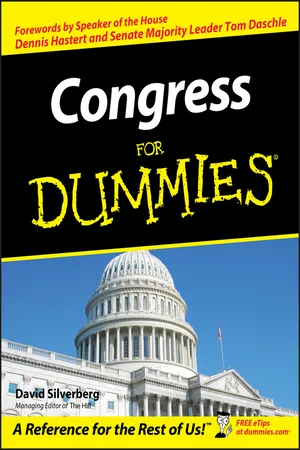
- English
- ePUB (mobile friendly)
- Available on iOS & Android
Congress For Dummies
About This Book
A clear, direct guide into the nitty-gritty workings of Congress and the way the institution really functions Congress For Dummies helps you sort out what Congress does on a daily basis and what it all means to you, the citizen. It shows you how to get organized, make your voice heard, and influence legislation that might affect you. Full of helpful resources such as contact information for House and Senate offices, and smart, straightforward explanations of the legislative process, this book is everything you need to understand Congress and get involved in your government.
Whether you just want to know how government works, or you want to get involved to change your country, this simple guide covers all the ins and outs of Congress. It's a nonpartisan look at Congress that includes forewords by Speaker of the House Dennis Hastert and Senate Minority Leader Tom Daschle. Inside you'll find easy explanations and helpful tips on how to:
- Get involved in the democratic process
- Influence legislation that's important to you
- Understa nd Congress and the media
- Contact your senators and representatives
- Check out Congress in action, in person
- Deal with congressional staff
Expert author David Silverberg — Managing Editor and a columnist at the Washington weekly The Hill — takes the mystery out of getting something done in Congress, introducing you to the players and explaining everything from legislation and lobbying to caucuses and coalitions. Written with the citizen advocate in mind, this helpful guide gives regular people the tools and knowledge they need to achieve their aims. Inside, you'll discover:
- How the three branches of government work together
- How to register your opinion with your elected officials
- How the legislative process works — from idea to law
- How debates, conferences, and vetoes work
- How budgeting and appropriations work
- How to get the most effect from your political contributions
- How the lobbying process works
- How to advocate for legislation
- How to deal with congressional staffers
- How to make use of congressional services
Getting something done in the messy confusion of democracy and bureaucracy is no easy task. Full of the kind of information and knowledge that Washington insiders take for granted, Congress For Dummies levels the playing field so that regular people — just like you — can make a difference, too.
Frequently asked questions
Information
Part I
Considering the Two Chambers

Chapter 1
Welcome to Congress
In This Chapter




The Three Branches of Government
The congressional branch


















Why we have two chambers
Table of contents
- Title
- Contents
- Introduction
- Part I : Considering the Two Chambers
- Chapter 1: Welcome to Congress
- Chapter 2: Running Your House: The House of Representatives
- Chapter 3: Scoping Out the Senate
- Part II : Looking at the Legislative Process
- Chapter 4: Introducing a Bill
- Chapter 5: Meeting the Players, Setting the Schedule
- Chapter 6: Reaching the Floor and Beyond
- Part III : Following the Money
- Chapter 7: Raising Revenues
- Chapter 8: Budgeting, Authorizing, and Appropriating Government Money
- Chapter 9: Putting Your Political Contributions to Work
- Part IV : Lobbying from All Angles
- Chapter 10: Looking at Lobbying
- Chapter 11: Explaining Your Cause
- Chapter 12: Getting Down to the Nitty-Gritty: Lobbying Members of Congress
- Chapter 13: Getting the Job Done: Congressional Staff
- Chapter 14: Making the Most of the Media
- Chapter 15: Working with Various Media
- Part V : Putting the Practical Side to Use
- Chapter 16: Making Use of Congressional Services
- Chapter 17: Visiting Congress
- Part VI : The Part of Tens
- Chapter 18: Ten Tips for Conducting a Lobbying Campaign
- Chapter 19: The Ten Commandments for Dealing with Congressional Staff
- Chapter 20: Ten Tips for Dealing with Journalists
- Chapter 21: Not Even Ten Suggestions for Improving Congress
- Part VII : The Appendixes
- Appendix A: Glossary of Congressional and Political Terms
- Appendix B: Committees of the 107th Congress